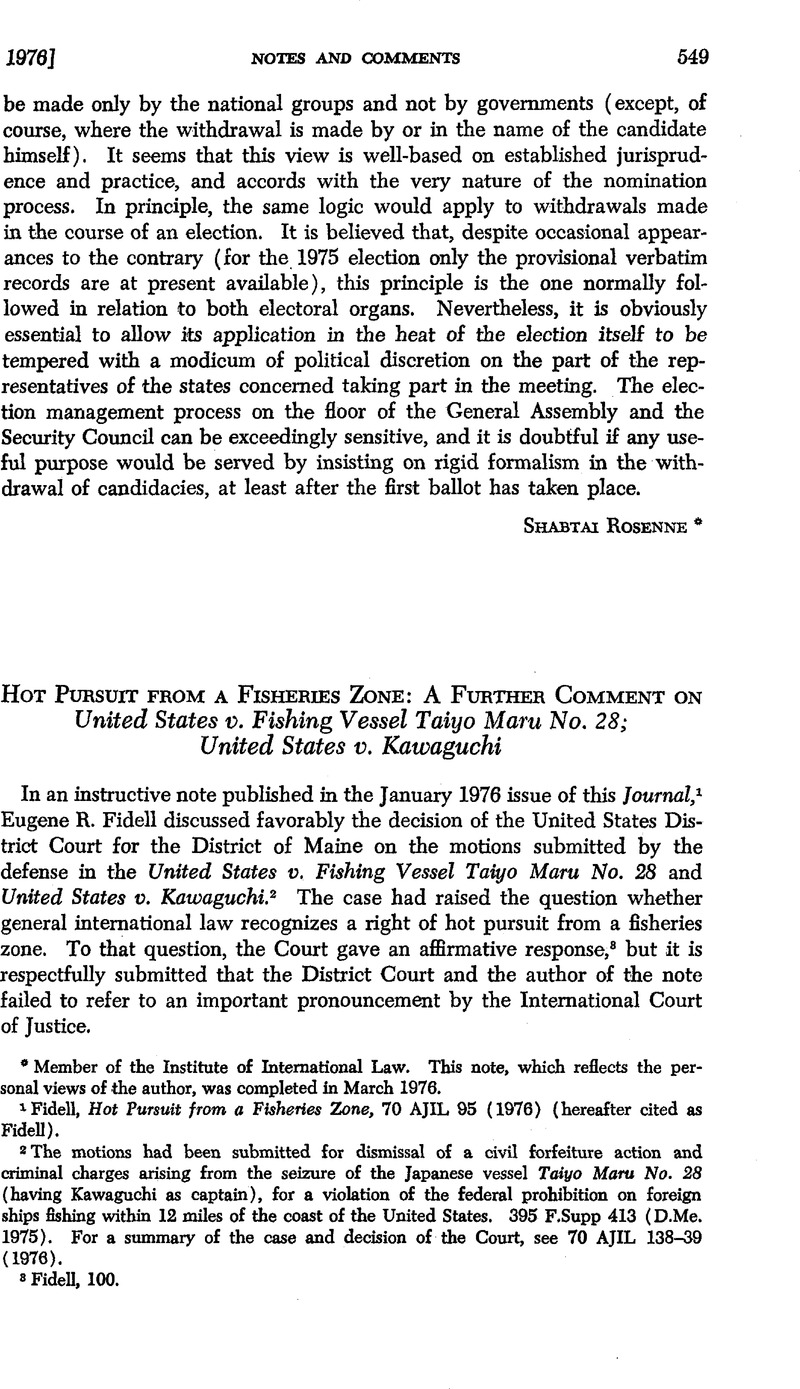No CrossRef data available.
Article contents
Hot Pursuit from a Fisheries Zone: A Further Comment on United States v. Fishing Vessel Taiyo Maru No. 28; United States v. Kawaguchi
Published online by Cambridge University Press: 27 February 2017
Abstract

- Type
- Notes and Comments
- Information
- Copyright
- Copyright © 1976 by The American Society of International Law
References
1 Fidell, , Hot Pursuit from a Fisheries Zone, 70 AJIL 95 (1976) (hereafter cited as Fidell).Google Scholar
2 The motions had been submitted for dismissal of a civil forfeiture action and criminal charges arising from the seizure of the Japanese vessel Taiyo Maru No. 28 (having Kawaguchi as captain), for a violation of the federal prohibition on foreign ships fishing within 12 miles of the coast of the United States. 395 F.Supp 413 (D.Me. 1975). For a summary of the case and decision of the Court, see 70 AJIL 138–39 (1976).
3 Fidell, 100.
4 Id. 99.
5 Id. 99–100. For the content of this provision, see infra at footnote 17.
6 Fidell, 95–96.
7 395 F.Supp. at 419.
8 According to Article 2, paragraph 1, of the Geneva Convention on the High Seas, the freedom of the high seas comprises, inter alia, the freedoms of fishing and navigation. Done Apr. 29, 1958, 15 UST 2312; TIAS No. 5200; 450 UNTS 82; 52 AJIL 842 (1958). It may be also useful to recall that the Preamble of the Convention characterizes its provisions as “generally declaratory of established principles of international law,” and in the Fisheries Jurisdiction cases the International Court of Justice accepted that characterization. [1974] ICJ Rep. 22.
9 Fidell, 99.
10 [1974] ICJ Rep. 23.
11 Emphasis supplied.
12 Memorandum in Opposition to Defendant’s Motion to Dismiss for Lack of Jurisdiction, quoted by Fidell at 98.
13 The cases cited by Fidell, even together with several others, could hardly suffice for the formation of a rule of customary international law conferring on coastal states the right of hot pursuit from their fisheries zone at a time when the very concept of an “exclusive fisheries zone” was an open question.
14 Fidell cites Professors Knight and Poulantzas (at 97 and 99). However, the observation made by the Permanent Court of International Justice in the Lotus case [1927 PCIJ ser. A. No. 10, at 26] invites caution in this regard.
15 Fidell, 101.
16 [1974] ICJ Rep. 39.
17 Convention on the Territorial Sea and the Contiguous Zone. Done Apr. 29, 1958, 15 UST 1606; TIAS No. 5639; 516 UNTS 205; 52 AJIL 834 (1958). Article 24, para. 1 reads as follows:
In a zone of the high seas contiguous to its territorial sea, the coastal state may exercise the control necessary to: (a) Prevent infringement of its customs, fiscal, immigration or sanitary regulations within its territory or territorial sea; (b) Punish infringement of the above regulations committed within its territory or territorial sea.
In its commentary on Article 47 of its Draft Articles on the Law of the Sea (which became Article 23 of the Geneva Convention on the High Seas), the International Law Commission made it unmistakably clear that “a State which has established a contiguous zone for the purposes of customs cannot commence hot pursuit of a fishing boat accused of unlawful fishing in the territorial sea if the fishing boat is already in the contiguous zone.” 2 Y.B. Int’l L. Comm’n 285 (1956).
18 In its commentary on Article 66 of its Draft Articles on the Law of the Sea (Article 24 of the Geneva Convention on the Territorial Sea and the Contiguous Zone), the International Law Commission stressed that “international law accords States the right to exercise preventive or protective control for certain purposes over a belt of the high seas contiguous to their territorial’ sea (supra note 17, at 294). Then, in its commentary on Article 47 (Article 23 of the Geneva Convention on the High Seas), the Commission reported that the majority of its members “was of the opinion that the right of hot pursuit should also be recognized when the ship is in a zone contiguous to the territorial sea, provided such pursuit is undertaken on the ground of violation of rights for the protection of which the zone was established (id. at 285). One could, therefore, infer that the Commission considered the hot pursuit as an admissible means for the protection of rights recognized by the law of the sea. To put it in the words of Bierzanek, the delegate from Poland in the Second Committee (High Seas: General Régime) of the United Nations Conference on the Law of the Sea, “there seemed to be no point in establishing a contiguous zone if the rights for which it had been established could not be enforced by pursuit.” 4 UN Conf. on the Law of the Sea 82, UN Doc. A/CONF.13/40 (1958).
19 Fidell, 95 and 101.




